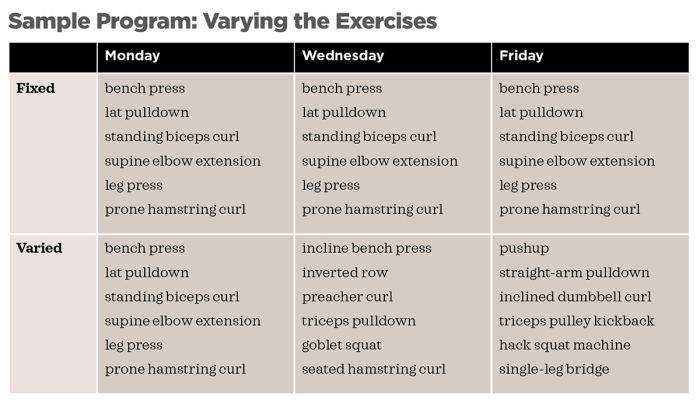What’s resistance training – Resistance training, the art of challenging your muscles against an opposing force, is a cornerstone of any well-rounded fitness regimen. Its transformative power extends beyond mere aesthetics, delving into the realms of enhanced strength, improved mobility, and overall well-being.
In this comprehensive guide, we’ll delve into the multifaceted world of resistance training, unraveling its benefits, exploring its diverse forms, and equipping you with the knowledge to harness its potential for a healthier, stronger you.
Benefits of Resistance Training
Resistance training offers numerous benefits for both physical and mental health. It helps build muscle mass, strength, and power, while also improving mood, cognitive function, and self-esteem.
Physical Benefits
* Increased muscle mass:Resistance training stimulates muscle protein synthesis, leading to an increase in muscle mass and size.
Improved strength
Regular resistance training helps develop strength in both large and small muscle groups.
Enhanced power
Power, the ability to generate force quickly, is improved through resistance training exercises.
Mental and Emotional Benefits
* Mood enhancement:Resistance training has been shown to release endorphins, which have mood-boosting effects.
Improved cognitive function
Studies suggest that resistance training can improve memory, attention, and executive function.
Increased self-esteem
Achieving strength and fitness goals through resistance training can lead to a sense of accomplishment and improved self-esteem. Supporting Statistics and Studies* The American College of Sports Medicine recommends resistance training for all adults to improve physical and mental health.
- A study published in the Journal of Strength and Conditioning Research found that resistance training can increase muscle mass by up to 15% in older adults.
- Research from the National Strength and Conditioning Association indicates that resistance training can improve mood and reduce symptoms of depression and anxiety.
Specific Examples of Health Improvements
* Resistance training can help reduce the risk of falls and fractures in older adults by improving balance and strength.
- It can also improve blood sugar control in individuals with type 2 diabetes by increasing insulin sensitivity.
- Resistance training can strengthen bones and reduce the risk of osteoporosis.
Table of Key Benefits
| Category | Key Benefits ||—|—|| Physical |
Increased muscle mass |
| |
Improved strength |
| |
Enhanced power |
| Mental |
Mood enhancement |
| |
Improved cognitive function |
| |
Increased self-esteem |
ConclusionResistance training is a crucial aspect of overall health and fitness. Its numerous benefits include increased muscle mass, strength, and power, as well as improved mood, cognitive function, and self-esteem. Incorporating resistance training into a regular exercise routine is essential for maintaining a healthy and active lifestyle.
How Resistance Training Works

Resistance training, also known as strength training, is a form of exercise that involves contracting muscles against resistance. This resistance can come from weights, machines, or even just your own body weight. When you perform resistance training, you are essentially creating tiny tears in your muscle fibers.
This damage triggers a repair process that leads to the growth of new, stronger muscle tissue.In addition to increasing muscle mass, resistance training also has a number of other benefits, including:* Increased bone density
- Improved joint stability
- Reduced risk of injury
- Improved balance and coordination
- Increased metabolism
- Reduced body fat
- Improved mood
Physiological Mechanisms Involved in Resistance Training
Resistance training works by stimulating a number of physiological mechanisms, including:* Muscle protein synthesis:Resistance training increases the production of muscle protein synthesis, which is the process by which new muscle tissue is created.
Satellite cell activation
Resistance training activates satellite cells, which are stem cells that can differentiate into new muscle cells.
Hormonal responses
Resistance training triggers the release of a number of hormones, including growth hormone and testosterone, which promote muscle growth.
Hormonal Responses to Resistance Training
Resistance training triggers the release of a number of hormones, including:* Growth hormone:Growth hormone is a hormone that promotes muscle growth and repair. It is released in response to resistance training and other forms of exercise.
Testosterone
Testosterone is a hormone that promotes muscle growth and strength. It is released in response to resistance training and other forms of exercise.
Insulin-like growth factor-1 (IGF-1)
IGF-1 is a hormone that promotes muscle growth and repair. It is released in response to resistance training and other forms of exercise.
Simplified Diagram Illustrating the Process of Resistance Training
[Insert simplified diagram or infographic illustrating the process of resistance training here]
Resistance Training for Different Populations
Resistance training offers numerous benefits across diverse populations. Tailoring training plans to specific needs and conditions ensures optimal results and safety.
Resistance Training Recommendations for Different Age Groups
Age-appropriate recommendations for resistance training vary to accommodate physical capabilities and development:
| Age Group | Frequency | Intensity | Volume | Rest |
|---|---|---|---|---|
| Children (6-12 years) | 2-3 times per week | 50-70% of 1RM | 1-3 sets of 8-12 repetitions | 2-3 minutes |
| Adolescents (13-18 years) | 2-4 times per week | 60-80% of 1RM | 2-4 sets of 8-12 repetitions | 2-3 minutes |
| Adults (19-64 years) | 2-3 times per week | 60-85% of 1RM | 2-4 sets of 8-12 repetitions | 2-3 minutes |
| Older Adults (65+ years) | 2-3 times per week | 50-70% of 1RM | 1-2 sets of 10-15 repetitions | 3-5 minutes |
Modifications for Individuals with Specific Conditions
Individuals with specific health conditions may require modifications to their resistance training programs to ensure safety and effectiveness:
- Arthritis:Focus on low-impact exercises, such as swimming or cycling, and avoid exercises that aggravate pain.
- Osteoporosis:Prioritize weight-bearing exercises, such as walking or dancing, to promote bone density.
- Heart Disease:Consult with a healthcare professional before starting any resistance training program and monitor intensity and duration carefully.
- Diabetes:Resistance training can help improve blood sugar control; however, individuals should monitor blood sugar levels and adjust insulin doses accordingly.
- Pregnancy:Avoid exercises that involve lying on the back or straining the abdominal muscles; modify exercises to ensure comfort and safety.
Resistance Training for Pregnant or Postpartum Women, What’s resistance training
Resistance training during pregnancy and postpartum can provide numerous benefits, including reducing back pain, improving posture, and strengthening muscles:
- During Pregnancy:Focus on exercises that do not put strain on the abdomen, such as squats, lunges, and arm exercises using light weights or resistance bands.
- Postpartum:Gradually reintroduce resistance training after consulting with a healthcare professional. Start with light weights and low intensity, and gradually increase as tolerated.
Resistance Training Equipment

Resistance training equipment is a crucial component of any effective resistance training program. There are various types of equipment available, each with its own unique features, pros, and cons. Choosing the right equipment depends on individual fitness goals, experience level, and budget.
Types of Resistance Training Equipment
1. Free Weights
Dumbbells and barbells are the most common types of free weights. They offer a wide range of exercises and allow for customization of resistance.
2. Weight Machines
Weight machines are designed to isolate specific muscle groups and provide a guided movement path. They are often safer for beginners but limit exercise variety.
3. Resistance Bands
Resistance bands are portable and versatile, offering variable resistance throughout the range of motion. They are great for home workouts and rehabilitation.
4. Bodyweight Exercises
Bodyweight exercises use your own body as resistance. They are convenient, cost-effective, and can be modified to suit different fitness levels.
5. Kettlebells
Kettlebells are versatile weights with a unique shape that allows for dynamic movements. They are great for building strength, power, and endurance.
Comparison of Resistance Training Equipment
| Equipment | Cost | Space Requirements | Versatility | Durability | Safety ||—|—|—|—|—|—|| Free Weights | Moderate | High | Excellent | High | Moderate || Weight Machines | High | Moderate | Limited | High | High || Resistance Bands | Low | Low | Excellent | Moderate | Moderate || Bodyweight Exercises | Free | None | Limited | Moderate | Low || Kettlebells | Moderate | Moderate | Good | High | Moderate |
Choosing the Right Equipment
Consider the following factors when selecting resistance training equipment:
Fitness Goals
Different equipment suits different goals (e.g., strength, endurance, rehabilitation).
Experience Level
Beginners may prefer guided movements of weight machines, while advanced lifters can handle free weights.
Budget
Free weights and bodyweight exercises are more affordable than weight machines and kettlebells.
Examples of Exercises
Free Weights
Dumbbell curls, bench press, squats
Weight Machines
Leg press, chest press, lat pulldowns
Resistance Bands
Bicep curls, tricep extensions, shoulder presses
Bodyweight Exercises
Push-ups, squats, lunges
Kettlebells
Swings, snatches, cleans
Safety Precautions
- Use proper form and technique to prevent injuries.
- Start with a manageable weight and gradually increase resistance.
- Warm up before workouts and cool down afterward.
- Listen to your body and stop if you experience any pain.
- Supervise beginners or those with health conditions.
Resistance Training Programs

Designing a personalized resistance training program involves tailoring it to your individual fitness level, goals, and needs. Consider the following steps:
- Establish goals:Define your specific fitness objectives, whether it’s building muscle, improving strength, or enhancing endurance.
- Assess fitness level:Determine your current strength and fitness capabilities through self-assessment or a fitness evaluation.
- Select exercises:Choose exercises that target the muscle groups you want to develop, considering their complexity and your fitness level.
- Set intensity:Determine the appropriate weight or resistance based on your fitness level and goals, ensuring it’s challenging but achievable.
- Determine sets and repetitions:Decide on the number of sets (groups of exercises) and repetitions (individual exercises within a set) that suit your goals and fitness level.
- Plan frequency and duration:Establish how often you’ll train per week and the duration of each session, considering your recovery needs and schedule.
Sample Resistance Training Programs
Beginner Program:
- 2-3 days per week
- 1-2 sets of 10-12 repetitions
- Focus on compound exercises (e.g., squats, push-ups, rows)
- Rest 60-90 seconds between sets
Intermediate Program:
- 3-4 days per week
- 2-3 sets of 8-12 repetitions
- Include isolation exercises (e.g., bicep curls, tricep extensions)
- Rest 45-75 seconds between sets
Advanced Program:
- 4-5 days per week
- 3-4 sets of 6-10 repetitions
- Incorporate advanced techniques (e.g., supersets, drop sets)
- Rest 30-60 seconds between sets
Progression and Periodization
Progression and periodization are crucial in resistance training. Progression involves gradually increasing the intensity, volume, or complexity of your workouts over time to challenge your muscles and promote continuous improvement. Periodization involves structuring your training into specific phases with varying goals and intensities, such as a strength phase, hypertrophy phase, or endurance phase.
Resistance Training for Specific Goals

Resistance training is a versatile form of exercise that can be tailored to achieve various fitness goals, including building muscle mass, losing weight, and enhancing athletic performance. Here’s how resistance training can be adapted for specific objectives:
Building Muscle Mass
To maximize muscle growth, focus on compound exercises that work multiple muscle groups simultaneously. Prioritize exercises like squats, deadlifts, bench press, rows, and overhead press. Use weights that challenge you while maintaining good form. Aim for 8-12 repetitions per set, with 3-4 sets per exercise.
Rest for 1-2 minutes between sets.
Weight Loss
Resistance training can aid in weight loss by increasing muscle mass, which boosts metabolism. Choose exercises that target large muscle groups and incorporate them into a full-body workout. Consider circuit training, where you perform multiple exercises back-to-back with minimal rest.
Aim for 10-15 repetitions per exercise, with 2-3 sets per exercise. Rest for 30-60 seconds between sets.
| Program | Description |
|---|---|
| Bodyweight Training | Uses body weight as resistance, suitable for beginners. |
| Circuit Training | Alternates exercises with short rest periods, elevates heart rate. |
| High-Intensity Interval Training (HIIT) | Involves short bursts of intense exercise followed by rest or low-intensity periods. |
Improving Athletic Performance
Resistance training can enhance athletic performance by strengthening muscles, improving power, and increasing endurance. Choose exercises that mimic the movements involved in your sport. Use weights that allow you to perform 6-10 repetitions per set, with 2-3 sets per exercise.
Rest for 2-3 minutes between sets.
Ending Remarks
Resistance training is not just a means to an end; it’s a journey of self-discovery and empowerment. Embrace the challenge, witness the transformative power of resistance, and unlock the boundless potential that lies within you.
FAQ Resource: What’s Resistance Training
What exactly is resistance training?
Resistance training involves performing exercises against an opposing force, such as weights, resistance bands, or your own body weight, to build muscle strength and endurance.
How often should I do resistance training?
For optimal results, aim for 2-3 resistance training sessions per week, targeting different muscle groups each session.
Is resistance training safe for beginners?
Absolutely! Start with a manageable weight and gradually increase the resistance as you grow stronger. Proper form is crucial to prevent injuries.
Leave a Reply